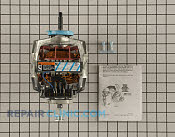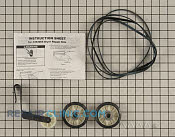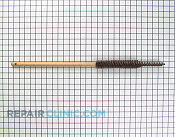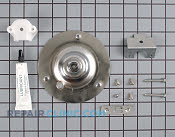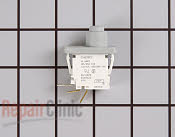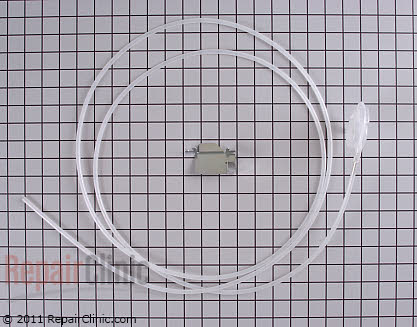To learn more about your refrigerator, or to order parts, click here.
Entering & using diagnostic mode on #Frigidaire top load #washer
Example model number: LTF2940ES3
Diagnostic Test:
The diagnostic test is performed by using the Program Knob.
To START THE TEST:
• On digital display models, turn the Program Knob to start position, Touch Up.
(NOTE: If the model has a timer dial that can be rotated 360°, turn the Program Knob to start position, Drain/Spin.
• Press Pause Cancel to turn off LEDs.
• Within 5 seconds, press and hold the Option and Pause Cancel buttons until LEDs start sequentially chasing, then release buttons.
1. All the LEDs will sequentially light. Pressing a button below a light cluster will light all the LEDs in that cluster at one time to confirm functionality.
2. Turn the program knob (1) click clockwise from the start position. The hot water solenoid will activate and hot water should enter through the detergent compartment.
3. Turn the program knob (2) clicks from the start position. The bleach water solenoid will activate and cold water should enter through the bleach compartment.
4. Turn the program knob (3) clicks from the start position. The bleach and the wash water solenoids will activate and cold water should enter through the softener compartment.
5. Turn the program knob (4) clicks from the start position. The door lock solenoid will activate.
6. Turn the program knob (5) clicks from the start position. The door lock solenoid will deactivate and the loading door can be opened.
7. Turn the program knob (6) clicks from the start position. The washer will fill and tumble.
8. Turn the program knob (7) clicks from the start position. The washer will fill and spin (leakage test).
9. Turn the program knob (8) clicks from the start position. The drain pump and door lock solenoid will activate and the
washer will operate in high spin. SAFETY WARNING: If power is removed during this test, the door can be opened.
To prevent injury, DO NOT put your hands inside when the tub is rotating.
10. Turn the program knob (9) clicks from the start position. The control will signal the last error code.
Exiting Diagnostic Mode
There are two options for exiting the Diagnostic Test mode and returning the washer to normal operation:
a ) Unplug the power cord, wait 5-8 seconds, then reconnect the power cord OR
b ) Turn the program knob clockwise 2 or 3 clicks after the Start Position. Press Options and Pause Cancel buttons together for a few seconds until wash cycle LEDs appear.
If a situation arises where you cannot exit the Diagnostic mode as described above and the bank of 5 LED’s on the right end remain ON regardless of Program Knob position,
a combination of pushed buttons may have caused the control to enter a special factory test mode.
Disconnect power to reset the control to return washer to normal operation is this occurs.
For manuals and lots of other goodies,
become an Apprentice in the Samurai School of Appliantology==> http://appliantology.org/apprentice/
To learn more about your washing machine, or to order parts, click here
How to test the touchpad on a #GE Profile #walloven
If you’re getting an error code on your GE wall oven and you’re not sure whether the bad actor is the touchpad or the electronic range control (ERC) board, use this cheat sheet to test the touchpad. If the touchpad checks out good, then replace the ERC. Ees seemple, da?
Ge Wall Oven Touchpad Ohm Test
To learn more about your range/stove/oven, or to order parts, click here.
Putting a #Samsung #refrigerator into forced #defrost mode
If you’re troubleshooting a defrosting problem with your Samsung refrigerator, one of the first things you’ll want to do is manually put it into defrost mode so you can use your meter and see if the control board is sending 120vac to the defrost heater. Here’s the procedure that’ll work for most current Samsung refrigerator models:
To buy parts for your Samsung refrigerator, click here.
Whirlpool dryer hums & kicks off or only runs a short time then kicks off
First, open the door and turn the drum by hand to make sure it’s not seized. If the drum won’t turn or is very hard to turn, then you may have either bad drum rollers or something stuck in the blower.
Okay, so the drum movement seems normal. Now you need to see if you’re getting voltage to the motor. Use the wiring diagram supplied with the dryer for the wires on which to check for voltage at the motor. Usually, it’s the blue and white wires. If you need help figuring this out, come start a new topic in the Laundry forum and we’ll get you going.
If you’re getting 120vac to the motor, then the motor is bad. You’ll need to replace it, click on the motor pic below to order; one year guarantee! Easy job– you can watch a how-to video on this page.
And you might as well do the maintenance kit while you’re in there; includes the belt, idler, and drum rollers.
To learn more about your dryer, or to order parts, click here.
Removing the spray arm from a GE GLD-model dishwasher
To learn more about your dishwasher, or to order parts, click here.
Disassembling the dispenser on an LG LRSC SxS refrigerator
LG LRSC SxS Refrigerator Dispenser Disassembly
To learn more about your refrigerator, or to order parts, click here.
Locating the CCU on a Kenmore HE5t front load washer
The Central Control Unit (CCU) is the electronic board that controls all the go-go on this Whirlpool-built machine. If you ever need to replace it, here’s where it lives:
And you can buy the replacement CCU ratcheer.
To learn more about your washing machine, or to order parts, click here.
How to find the model number on your major home appliance, snow blower, and lawn mower
If you’re trying to get repair help in the Samurai School of Appliantology or you need to find and order parts for your appliance, snow blower, or lawn mower, you gotsta have the full and correct model number. The photos and videos on this page will help you find it.
Replacing the rear bearing in a GE / Frigidaire dryer
Frigidaire used to make dryers for GE (example model number: WSM2700HBWWW) back when GE was too busy building shoddy Mark 1 nuclear power plants to build their own shoddy dryers; those came later… and they’re pretty damn shoddy. The Frigidaire-built units were better, though not nearly as good as the Whirlpool units with the lint filter in the top panel.
Anyway, if your Frigidaire-built GE dryer– or if your Frigidaire-built Frigidaire dryer– is making a squealing noise in back, you probably need to replace the rear bearing kit.
Here’s the link to the bearing kit which includes a how-to video:
To learn more about your dryer, or to order parts, click here.
Whirlpool Duet electric dryer- three fast beeps when you press the start cycle button
Example model number: GEW9200
This problem is caused by a bad door switch. Here’s the link to the door switch, click the picture:
You can test using an ohmmeter. There are 3 prongs on switch, identified as C,NC, and NO.
C-NC should be closed circuit until you push switch and then it should be open.
C-NO should be open circuit until you push switch and then read closed.
Buying the switch through this site is a risk-free proposition because you can return the switch for a refund if that doesn’t fix it. ![]()
Tips for installing the anti-drip kit in an older Whirlpool or Kitchenaid refrigerator
The dispensers on some of these older Whirlpool-built refrigerators are famous for the annoying and potentially floor-damaging drip-drip-drip problem where water will continue to drip for some time after dispensing water. Changing the water inlet valve or checking house water pressure are probably wild goose chases on this one.
Turns out there’s a design flaw in these units that use a coil of tubing for the water “tank” inside the refrigerator. When water is dispensed, it’s immediately replaced by warmer water from outside the refrigerator. As the water cools, it expands. In the coiled-tube tank, there’s no place for it to expand except to force its way out the nozzle, much to the dismay of many owners of these refrigerators.
Fortunately, there is a fix and it’s not too bad of a spanking. You need to install this tubing kit, sometimes called “the slurp kit.”
The kit comes with instructions but they don’t apply to models made between 2000 and 2001. But not to worry, Grasshoppah, because the Samurai shall be your beacon of appliantological wisdom in this dark time of your appliance morass.
First, you’ll unsnap the dispenser frame off. Underneath the bottom edge of the frame, you will see two slots. Just take a flathead screwdriver and pop that plastic frame off, then you can get good access to it.
Depending your manual finesse level, you may need to remove the control bracket, called out in the diagram. The dispenser nozzle is also labelled in the diagram.
Next, drop down on your knees and pull the toe grill off. Undo the union connector behind the grill. Remove the nozzle retaining screw and pull the tubing up from the front dispenser.
When installing this new one, push the new tubing down through the channel hole that the old one was in all the way down. Then just get something small to fish up in the bottom of your door channel, like a stubby screwdriver or pocket screwdriver and pull the tubing down. Another pair of hands can save some adult language that might otherwise be forthcoming to push down on the tubing while you fish it through the bottom.
Don’t worry, I’ve changed lots of these and never even came close to breaking the line half way through the door when pull it out from the front dispenser.
To learn more about your refrigerator, or to order parts, click here.
Return policy on appliance parts purchased through all Samurai Appliance Repair Websites: 365 Days. Period.™
No harm in buying and trying! Electrical parts? Out of stock parts? No problem! Get a free replacement or your money back if you return a part within one full year. This is the best return policy in the industry and applies to all parts purchased through any of the Repairclinic banners and links at all Samurai appliance repair websites: www.appliantology.org, www.fixitnow.com, www.applianceguru.com, and fixitnow.posterous.com.
Disassembling an LG electric dryer to test or replace the thermostat and thermal limiter
Let’s listen with amazement as Sublime Master john63 from the Samurai School of Appliantology unveils the mysteries of disassembling an LG dryer. This particular procedure was for model number DLE7177WM but is largely applicable to all current LG models.
1) Unplug the dryer.
2) Remove 3 “phillips” screws from the TOP COVER of the dryer. These screws are at the rear of the top cover.
3) Slide the top cover rearward about an inch & lift-off.
4) Open the DOOR of the dryer & remove 2 screws under the *opening*. Roughly located at the 5 and 7 O’clock locations.
5) Standing in front of the dryer & looking behind the control panel—unplug all wire connections to the MAIN BOARD.
6) Now remove the screws from the *corners* of the CONTROL PANEL (Note: Some dryers only have one screw on the right side
7) Grasp the top of the CONTROL PANEL & forcefully “peel” the panel off (This plastic is tough).
8) With the CONTROL PANEL removed—you’ll notice 4 screws that secure the FRONT COVER. Remove those & slowly tilt the FRONT COVER towards you—disconnect the DOOR SWITCH PLUG. Set aside the front cover. Step back & look at the front of the dryer. On the lower right side is a *white* plug. Squeeze the tab on this plug & pull apart to disconnect. This is the plug for the MOISTURE SENSOR. (During re-assembly—don’t forget this little guy).
9) Grab a FELT-TIP MARKER & place a *dot* next to the 2 screws on the front of the *silver* bracket that the CONTROL PANEL *snaps* onto. Then remove the 2 screws. Remove the other 2 screws at the top of the *silver* bracket and remove the silver bracket by pulling upward.
10) Remove 4 screws at each corner (or ear) of the FRONT DRUM SUPPORT ASSY.
11) Pull the SUPPORT ASSY upward & towards you–set aside.
12) Grab the DRUM & rotate counterclockwise while pulling towards you. The belt will slip off. Remove the DRUM.
13) You’ll see a silver/square box on the right-hand side. Pull off the wires to the THERMAL LIMITER & test it for *continuity* with the test meter. If “open”—replace the THERMAL LIMITER and the other THERMOSTAT next to it.
14) If the THERMAL LIMITER has failed—the home exhaust vent *must* be cleaned. 100%.
15) Use a shop vac to clean everything up.
To learn more about your dryer, or to order parts, click here.
“What’s that wire thing dangling from under the icemaker in my LG refrigerator?”
That would be the temperature sensing thing called a thermistor. The icemaker uses it to make decisions about when to make ice.
This particular example is from an LG refrigerator model LRSC26923TT but all the LG models are similar. Samsung’s icemaker’s use the same thermistor arrangement, too.
Usually the thermistor can be clipped right back in place as shown below:
If yours is broken for some reason, you’ll need to replace the icemaker, which you can get right here for the LG model LRSC26923TT ==> http://www.repairclinic.com/PartDetail/Ice-Maker-Assembly/1266867?modelNumber=LRSC26923TT
For other models and brands, you can look up the icemaker using your model number on the icemaker page, right here ==> http://www.repairclinic.com/Ice-Maker-Parts



